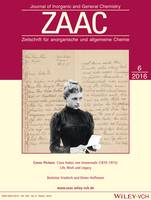What is the origin of the myth of Clara Immerwahr?
Apparently, it all began in the early 1940s in the U.S., when a fellow of the name Morris Goran started stalking German émigré scientists. We don't know whether Goran, who was neither a scientist nor a historian, worked for himself or for an agency. One of the scientists whom Goran sought to interview was a former Haber collaborator, James Franck. Franck later stated that he had declined to talk to Goran and characterized him as someone who wanted to aggrandize himself by publishing a book about a great man such as Fritz Haber. This did not prevent Goran from including Franck among his sources.
Goran published in 1947 a biographical article about Haber and in 1967 a book entitled The Story of Fritz Haber, where he stated that Clara was “vitally affected” by her husband’s involvement in WWI chemical warfare and committed suicide after a heated argument with Fritz about what she considered to be “a perversion of science” and “a sign of barbarism.“ Goran gives no evidence or sources for either this scenario or these statements. Apparently, the much-quoted phrase about the perversion of science and barbarism, ascribed to Clara, is Goran’s own. On the remainder of roughly three pages that he dedicated to Clara of the two-hundred-page Haber biography, Goran also points out that she was depressive. Although Goran doesn’t give any references here either, most of the available sources suggest that Clara was indeed depressive and that the depressions that hit her in her later life had to do with her unhappy and unfulfilling married life on the side of Fritz Haber.
Goran’s ill-founded scenario about Clara’s suicide as being connected with Fritz Haber’s involvement in chemical warfare was then appropriated and amplified by Gerit von Leitner in her widely read book Der Fall Clara Immerwahr.
Was there a chance for Clara to go back to science, to return to the laboratory and do research?
That’s a good question. Apart from societal barriers that made it virtually impossible for women in turn-of-the-century Prussia to find employment as scientists/chemists, Clara’s son Hermann, born in 1902, a year after Fritz and Clara were married, was a sickly child, who required a lot of care. And Clara had become sickly as well. Moreover, until Fritz Haber’s promotion to full professorship in 1906, the Habers were not well off and Clara had to do most of the household work by herself. Nevertheless, so long as her health and that of her son had permitted, Clara freelanced as an instructor in the continued education of women, mostly housewives, while struggling not to become a housewife herself.
In a letter from 1901 to Richard Abegg, Clara declared that she will get back to the laboratory „… once we become millionaires and will be able to afford servants. Because I cannot even think about giving up my [scientific work].“ As we know, the Habers did become rich, but Clara would never return to the laboratory nevertheless. As years went by, she would fall increasingly into the traditional role of a representative professorial wife, a housewife preoccupied with the well-being of the family and a caring mother. This was aggravated by Haber’s dog-eat-dog mentality and his obsession with his work and career, which left little room for Clara’s professional development and reduced her more and more to a house-mother.
However, Fritz Haber had something to show for his workaholism – and Clara, like anybody familiar with Haber’s work, must have been well aware of it. The discovery of the catalytic synthesis of ammonia is but one of many of Haber’s achievements, albeit perhaps the most significant among those that “have conferred a benefit to mankind.”
Would you think, if Fritz had been a woman and Clara had been a man, would Clara have become the director of the Kaiser Wilhelm Institute and Fritz just a “house-man”?
Perhaps. I don’t know how much genius for science Clara had shown before her marriage. But I don’t have a good sense for how much of a prodigy Fritz Haber had been either. However, in his first academic job, at the Technische Hochschule Karlsruhe, he became extremely accomplished very quickly. His slow promotion to the rank of a full professor was perceived as a scandal in some quarters – and a manifestation of anti-Semitism.
In the last chapter Gerit von Leitner claims that Clara wrote a farewell letter before committing suicide and that the housekeepers had seen the letter but that it was destroyed. Did you find any farewell letter of Clara Immerwahr?
No, there is no such letter.
Could you personally imagine that Clara wrote a farewell letter? Do you know the statistics of how many suicide victims write farewell letters?
I’m sorry, but I’m quite ignorant about the sociology of suicides. If it’s true that, as Hermann Lütge, the fine-mechanic, had testified, Clara found her husband during the fateful night in flagranti with another woman, it’s not too difficult to imagine that she had been quite distraught. I don’t know whether people in such situations write farewell letters. More to the point, I have no knowledge of whether Clara wrote such a letter.
Lütge gave his testimony 40 years afterwards. In flagranti with Charlotte Nathan, who would become Haber’s second wife?
Apparently.
And she, Charlotte Haber, had denied having been in the Haber mansion on May 2nd 1915.
Yes, Charlotte contradicted it in her memoirs, published in 1970, by stating the year of her acquaintance with Haber as 1917. However, given her job at the club “Deutsche Gesellschaft 1914,“ Fritz Haber, an early member, and Charlotte must have known each other since about 1914.
Where, in which journal will your article be published?
We submitted the article to Zeitschrift für Allgemeine und Anorganische Chemie, which published an article on Clara in 2012. Moreover, in 1900, Zeitschrift für Anorganische Chemie was the venue for the publication of one of Clara's own papers.
What do you think is Clara Haber’s legacy?








